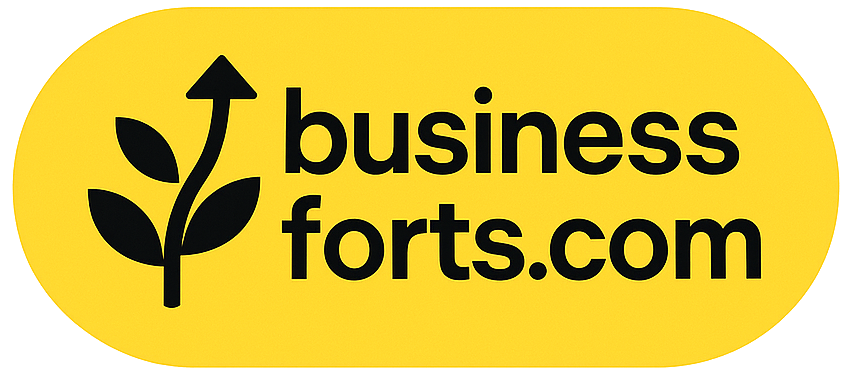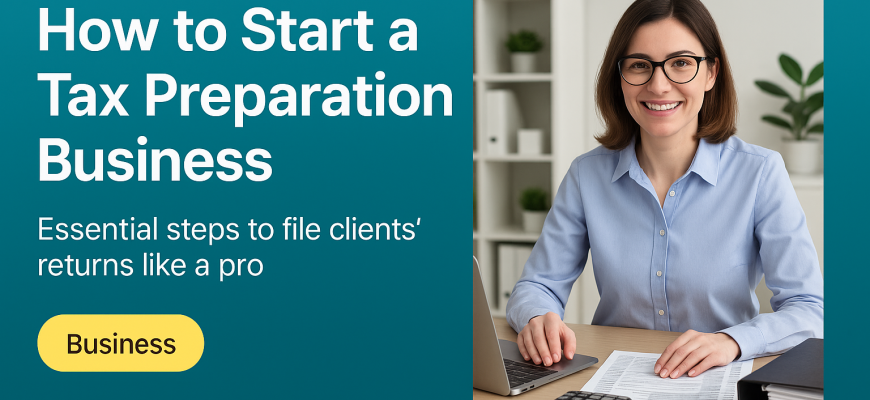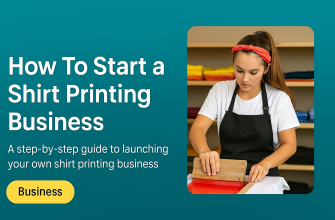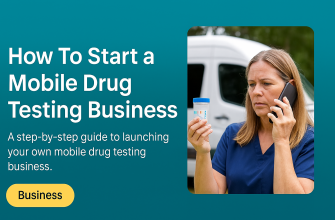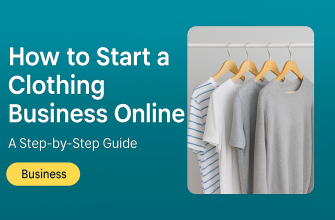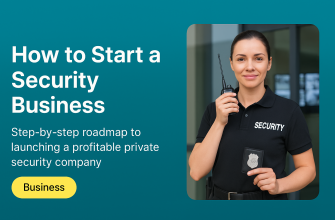Starting your own tax preparation business can be a rewarding and empowering journey. As a woman entrepreneur, you have a unique opportunity to build a flexible career helping others navigate a complex but essential service. In fact, women already thrive in the tax industry – over 70% of tax preparers in the U.S. are women. This guide will walk you through practical steps (with U.S.-specific requirements) and offer warm, actionable advice to get you started on the right foot.
Why Start a Tax Preparation Business?
A tax preparation business offers both steady demand and personal flexibility. Every year, millions of individuals and small businesses need help filing taxes because the U.S. tax code is complex and ever-changing. By starting your own practice, you can tap into this constant need while working on your own terms – whether that means setting your own hours, working from home, or focusing on clients you relate to. You’ll also find meaning in the work: clients truly value a trustworthy tax preparer who can save them money and reduce stress during tax season.
Importantly, launching a tax prep business has a relatively low startup cost and doesn’t require an advanced degree. If you are detail-oriented, good with numbers, and enjoy helping people, this field is a great fit. Many women entrepreneurs appreciate that they can start solo (even part-time) and grow at their own pace. With dedication and the right approach, your tax business can provide a solid income while you retain control over your schedule and mission. Remember, you’re not alone on this path – there’s a supportive community (and coaches like Alex Rivers!) ready to cheer you on.
Navigating U.S. Regulatory Steps
Before you start preparing returns for clients, you’ll need to take care of a few legal and regulatory requirements in the United States. This may sound daunting, but each step is very doable. Here are the key steps to get your business legally ready:
-
Register Your Business: Decide on a business structure (many solo tax preparers start as sole proprietors or form an LLC for liability protection). Register your business name with your state and obtain any required local business licenses. Don’t forget to open a separate business bank account to keep finances organized. You may also need an Employer Identification Number (EIN) from the IRS if you have employees or chose an LLC/Corporation.
-
Get a PTIN (Preparer Tax Identification Number): A PTIN is a must-have credential from the IRS for anyone who prepares federal tax returns for pay. You are legally required to obtain a PTIN before preparing returns for clients. The good news: there are no specific education requirements to get a PTIN, and you can apply online in about 15 minutes. The IRS charges a modest fee (under $20) for a PTIN application and you’ll need to renew it each year. Once you have your PTIN, you’re officially authorized to prepare federal tax returns.
-
Apply for an EFIN (Electronic Filing Identification Number): An EFIN is needed if you plan to electronically file tax returns on behalf of clients. In fact, IRS rules mandate e-filing if you prepare 11 or more returns, which means an EFIN becomes essential as your business grows. You can apply for an EFIN through the IRS website; the process involves a background check and fingerprinting (for security) and can take up to 45 days for approval. Plan ahead so you have your EFIN by the time you’re ready to file your first batch of returns. (Note: if you’re truly doing very few returns, you could paper-file, but most clients and preparers prefer the speed of e-filing.)
-
Check State-Level Requirements: Beyond federal IRS requirements, some states require tax preparers to have a separate license or registration. For example, states like California, Maryland, New York, Oregon, Connecticut, Illinois, and Nevada have their own preparer certification or registration rules. These often involve a state-administered course or exam and a registration fee. Be sure to research the rules for your state (or any state where you’ll serve clients) by visiting the state’s taxation or consumer affairs website. If your state has no special license for tax preparers, you can breathe easier – just focus on the federal steps above. (And keep in mind, if you later become a CPA or Enrolled Agent, many state-specific requirements may be waived.)
Taking care of these regulatory steps gives your business a solid foundation. It might not be the most glamorous part of entrepreneurship, but each license or ID you obtain is a building block of credibility and compliance. Once this groundwork is laid, you can move on to the more exciting parts of launching your venture, knowing you’re operating within the law.
Key Certifications and Credentials to Boost Credibility (PTIN, AFSP, EA)
While you don’t need an advanced certification to start a tax prep business, earning additional credentials can set you apart and build trust with clients. As a new entrepreneur, being able to say “I have this certification” often boosts client confidence. Here are three key credentials to understand:
-
Preparer Tax Identification Number (PTIN): This is the baseline requirement we discussed above, issued by the IRS. Having a PTIN doesn’t in itself advertise expertise (since it’s required of all paid preparers), but it’s your first credential to show you are an official preparer. Make sure your PTIN is current and include it on the tax returns you file. All IRS-authorized tax preparers must have a PTIN – it’s essentially your tax preparer ID badge.
-
Annual Filing Season Program (AFSP) Record of Completion: The AFSP is a voluntary IRS program designed for non-credentialed preparers who want to demonstrate extra education and professionalism. To participate, you take 15-18 hours of continuing education each year and pass a test at the end of the coursework. Once you meet the requirements, you receive a Record of Completion from the IRS and get listed in the IRS’s public directory of tax preparers. Why do this? Being an AFSP participant shows clients you stay up-to-date on tax laws and care about quality. It also grants limited rights to represent your clients before the IRS on returns you prepared (though not as much as an EA or CPA would have). In short, AFSP is a nice credibility booster early in your career – it signals you’re not “just” doing the minimum, but actively pursuing excellence. The IRS itself says this program “recognizes the efforts of non-credentialed return preparers who aspire to a higher level of professionalism.”
-
Enrolled Agent (EA): The Enrolled Agent designation is often considered the gold standard for tax preparers. EAs are federally licensed tax experts authorized by the IRS. To become an EA, you must pass a rigorous three-part IRS exam (covering individual tax, business tax, and representation practices) and pass a background check. EAs also commit to ongoing continuing education (72 hours every three years) to maintain their license. The big advantage of being an EA is that you have unlimited practice rights – you can represent clients before the IRS in audits, appeals, or any matters, without restrictions. Branding yourself as an Enrolled Agent can greatly enhance your credibility, as it shows you have proven tax expertise. While becoming an EA requires effort and study, it’s something you can work toward as you gain experience. Many successful tax business owners choose to earn their EA credential within a few years of starting out.
Keep in mind, other credentials exist (CPA or tax attorney, for example), but those involve broader scopes or additional education. For a focused tax preparation business, the AFSP and EA are the primary designations to consider. Even if you start without them, be aware of these options – pursuing a certification can be a great goal for professional growth. As Alex Rivers often reminds her clients: continuing to learn and qualify yourself isn’t just about letters after your name, it’s about the confidence and knowledge you bring to the table. And yes, credentials can help attract clients – people trust a preparer who has demonstrated expertise and commitment to the field.
Setting Up Your Office and Tools of the Trade
One of the next big steps is getting your workspace and tools ready. This is where practical preparation meets your day-to-day workflow. The right tools will make your job easier, more efficient, and more professional. Here’s what to consider:
Home Office Setup: If you’re working from home, create a dedicated workspace that is comfortable, organized, and secure. You’ll be handling sensitive financial information, so ensure you have a secure computer (with updated antivirus software and password protection) and a reliable high-speed internet connection. Keep client files (physical or digital) in a secure location – for example, a locked file cabinet for papers and encrypted storage for digital documents. A quiet, well-lit space will help you focus and will come in handy if you meet clients or conduct video calls. Even though you’re at home, treat it like a “real” office each day – this mindset boosts productivity and professionalism.
Professional Tax Software: Tax preparation software is the backbone of your practice. Nearly all professional tax preparers use specialized software to prepare and file returns – these tools automate calculations, check for errors, and streamline electronic filing. When starting out, research which software fits your needs and budget. Many vendors offer products tailored to solo preparers or small practices. For example, Intuit’s ProSeries and Lacerte are popular in the industry, known for supporting collaboration and complex returns. Other well-regarded tax software for professionals include TaxSlayer Pro, Drake Tax, ATX, and TaxAct Professional. Look for features like: forms coverage (does it handle all the federal and state returns you need?), ease of use, customer support, and whether it’s cloud-based or installed on your computer. Some software companies have pay-per-return options or starter packages ideal for new businesses. Choosing the right software will save you time and help you serve clients efficiently – it’s like having a powerful assistant that keeps you compliant with the latest tax laws.
Additional Tools and Resources: Beyond tax prep software, think about what other tools can streamline your workflow. You might use a secure client portal or file-sharing service to exchange documents with clients safely (some tax software suites include this). Consider how you’ll handle appointments and communications – scheduling tools (like Calendly or Google Calendar) and a dedicated business phone line or VOIP service can be helpful. It’s also wise to invest in tax research resources or reference materials (the IRS website, tax guidebooks, or online research services) to look up complex issues when they arise. For ongoing learning, tap into educational tools: the IRS offers webinars and updates, and organizations like the National Association of Tax Professionals (NATP) provide courses to keep you sharp. As tax laws and technology change, make a habit of continual learning. This could mean setting aside time each off-season to take an update seminar or using the IRS Training Center resources. All these tools – physical, digital, and educational – will empower you to deliver excellent service.
Setting up with the right tools might require a small investment, but it pays off by increasing your accuracy and efficiency. Think of it like this: a roofer wouldn’t use a hammer if they could use a nail gun, and similarly, you as a tax preparer deserve tools that make your job smoother. By equipping yourself properly, you’ll feel more confident and project a professional image from day one.
Marketing Your New Tax Business
Now it’s time for a fun part of entrepreneurship – marketing your services and landing those first clients! Marketing might feel unfamiliar if you come from an accounting or finance background, but it’s simply about connecting with people who need your help. Let’s break down some effective marketing moves for a new tax preparation business:
-
Build a Brand and Online Presence: Start by giving your business a name and identity that resonates with your target clients. As a woman entrepreneur, you might choose a name that feels approachable and professional (and highlights you as the founder). Once you have a name, create a simple website – this is your digital storefront. Thanks to modern website builders (Wix, Squarespace, etc.), you can set up a clean website without coding. Your site should outline your services, your qualifications, and how to contact you. Next, set up social media profiles where your audience hangs out. For instance, a LinkedIn page can be great if you target small businesses, whereas a Facebook page or group might reach local families. Don’t forget to claim your Google Business listing (Google My Business) so that local clients can find you in search results or maps. Being listed on directories like Google, Yelp, or even the Yellow Pages online can boost your visibility. The key is to meet potential clients where they are looking – many people search online for tax help, so make sure you’re visible and have a consistent, professional brand across these platforms.
-
Networking and Community Outreach: Especially in service businesses, your personal network and word-of-mouth are powerful. Start by letting friends, family, and former colleagues know about your new tax prep services – they may become your first clients or refer others. Attend local small business networking events, community meet-ups, or industry gatherings (for example, if you specialize in helping creatives or consultants, go where they go). Because you’re targeting women entrepreneurs, consider joining women’s business associations or online communities where you can both contribute and mention your expertise. Carry business cards or digital contact info so it’s easy to share your details. You might even offer a free tax tips workshop at a local library or a webinar online; this positions you as a helpful expert and gently markets your services. The more people who know you and trust your knowledge, the more your phone will ring come tax season.
-
Define Your Niche and Services: Think about who you most want to serve and tailor your marketing to that niche. Perhaps you want to help fellow women entrepreneurs with their business taxes, or focus on a certain profession or community. Highlighting a niche in your marketing can actually attract clients more effectively than saying “I do all taxes.” For example, if you advertise “Tax Solutions for Freelance Creatives” or “Specializing in Small Business and Self-Employed Women,” the right people will see you as exactly the solution they need. Of course, you can still take on other clients too, but having a focus helps your marketing message stand out. Also, be clear about your range of services: do you only do annual tax returns, or also offer bookkeeping, payroll, or tax planning consultations? In the beginning, you might stick to straightforward tax prep for individuals and sole proprietors. Over time, you can expand (for instance, adding bookkeeping or year-round accounting services can create steady off-season income). Whatever you choose, make sure your marketing materials (website, brochures, conversations) clearly communicate the problems you solve and the value you bring.
-
Leverage Content and Social Proof: In today’s market, content is king for service businesses. Share useful tax tips or short articles on your blog or social media – this quality content showcases your expertise and provides value to potential clients before they even hire you. For example, a simple post like “5 Overlooked Tax Deductions for Coaches and Consultants” could catch the eye of your target audience and prompt them to contact you. Additionally, encourage happy clients to give you testimonials or reviews. A glowing review on Google or Yelp can do wonders to build trust with prospects. You might even politely ask early clients for a short written testimonial you can put on your website. This kind of social proof – seeing that others have had a great experience – reduces the risk in a new client’s mind when choosing you. Don’t be shy about celebrating wins on social media too (“Thrilled to have helped a client save $3,000 on her taxes!”) as long as it’s done professionally and with client permission. Every bit of positive buzz helps in these early stages.
-
Consider Targeted Advertising: Once you have the basics covered (website, social, networking), you can also experiment with some paid marketing to jump-start your client base. This could include running a small Facebook or Instagram ad targeting local business owners, listing your services on a platform like Thumbtack or Upwork, or sending out a direct mail postcard in your community. Paid ads should be done thoughtfully to avoid overspending; start small and see what works. Sometimes sponsoring a local event or offering a referral incentive (e.g., $20 off for any friend referred) can be effective. The Intuit blog recommends considering paid opportunities once your strategy is in place. The idea is to amplify your reach beyond your immediate circle, once you’re ready. Always track the results of any marketing effort (ask new clients how they found you) so you can focus on what works best.
Marketing can feel like a lot, but take it step by step. You don’t have to do everything at once. Begin with the free and easy tactics (online presence and networking) and build from there. Over time, your satisfied clients will become your best marketers, spreading the word about your reliable and friendly tax services.
Establishing Credibility and Trust
In the tax business, credibility is everything. People entrust you with sensitive financial details and the task of dealing with the IRS – they need to feel they’re in good hands. As a new entrepreneur, you might not have a decades-long reputation yet, but you can start establishing trust from day one with a few smart strategies:
-
Showcase Your Qualifications: Make sure potential clients know about any credentials, training, or experience you have. Proudly display the fact that you are an IRS-authorized tax preparer (you might say “IRS PTIN Registered Tax Preparer” on your materials). If you’ve completed the AFSP or earned an EA license, highlight that prominently on your website and business cards. Explain what it means, too – not everyone knows the term “Enrolled Agent,” so a tagline like “Enrolled Agent (IRS-Licensed Tax Expert)” helps people understand your expertise. By showcasing your credentials, you prove you have verifiable knowledge and a commitment to professionalism.
-
Prioritize Ethics and Accuracy: Always adhere to the highest ethical standards in your practice. This means keeping client information confidential, being honest about what you can and cannot do, and diligently following tax laws. It might go without saying, but never fudge a number or take a dubious position on a return just to please a client – your ethical reputation is priceless (and penalties for preparer fraud are severe). If you don’t know something, it’s okay to say “That’s a great question – I’ll research the answer for you.” Clients will trust you more when they see you value accuracy over quick answers. Over time, your track record of honest, error-free work will lead to word-of-mouth referrals. Remember, credibility is built one client at a time, through each interaction where you demonstrate integrity and competence.
-
Collect Testimonials and Reviews: Social proof can greatly boost your credibility. After you’ve successfully served a few clients, ask them for a brief testimonial or online review. Many happy clients will be glad to support a budding entrepreneur. A sentence or two about how you saved them time, money, or stress can be gold for your marketing. Post these testimonials on your website. Encourage clients to leave public reviews on Google or Yelp – when new prospects see 5-star feedback, they feel more secure choosing you. Make it easy: you can send clients a direct link to where they can write a Google review, for example. Promote those glowing reviews in your marketing (share them on social media or mention them in flyers). Hearing others sing your praises establishes that you are credible and deliver results.
-
Engage in Content and Education Marketing: Building credibility often means positioning yourself as a knowledgeable resource. One way to do this is through content marketing – sharing useful information freely to your audience. This might be through a blog on your website, a newsletter, short videos, or active social media posts with tips. Regularly providing insights on tax and business issues (like tax deadlines, deduction tips, changes in tax law) shows that you stay up-to-date and truly understand the field. Prospective clients will start seeing you as “the go-to tax guru” even before they meet you. Additionally, consider hosting free Q&A sessions or webinars on tax topics. For instance, a live Instagram or Facebook session where you answer common tax questions can both market your business and prove your expertise in real time. By giving value without immediately asking for anything in return, you build trust and name recognition.
-
Connect with Professional Communities: Joining professional organizations can enhance your credibility by association. Look into groups like the NATP (National Association of Tax Professionals) or NAEA (National Association of Enrolled Agents) if you become an EA. Membership in these groups often signals that you’re serious about your profession and adhere to industry best practices. They also provide support and resources which indirectly benefit your clients. Similarly, being active in your local Chamber of Commerce or women entrepreneur groups can increase your profile. When people see you involved in professional communities, they’ll naturally view you as more established and trustworthy. It’s a subtle cue, but it helps. Plus, these groups might list your business in their directory, adding another place where clients can verify you.
Above all, consistency is key to building trust. Show up consistently for your clients – be on time with appointments and filings, return calls and emails promptly, and keep your promises. Over time, these habits create a reputation that “she’s reliable and always has our back.” Your credibility grows with every positive client outcome and every bit of knowledge you accumulate. And as your business coach Alex would tell you: confidence is contagious. The more you believe in your own credibility (because you’ve put in the work), the more clients will mirror that belief.
You’ve Got This!
Starting a tax preparation business as a new entrepreneur is an exciting mix of challenge and opportunity. Yes, there are formal steps to take and lots to learn, but remember why you’re doing this – to build a business on your own terms and use your skills to help others. From getting your IRS credentials to choosing the right software, from marketing your services to earning clients’ trust, you are laying the groundwork for a venture that can grow and thrive for years to come.
Take it one step at a time, and don’t hesitate to seek support when you need it. Whether it’s advice from a mentor, resources from a professional association, or guidance from a coach like Alex Rivers, there’s a wealth of support for women entrepreneurs in the tax and accounting field. In this journey, every small win counts – your first client, your first glowing review, your first tax season successfully completed. Celebrate these milestones!
By following the guidance in this post – and infusing it with your own passion and perseverance – you’ll be well on your way to building a successful tax preparation business. Stay curious, stay compliant, and keep that warm, helpful attitude that draws clients to you. You’ve chosen a path that not only offers you independence, but also lets you make a real difference for people. So gear up, believe in yourself, and step forward with confidence!
